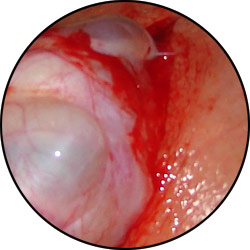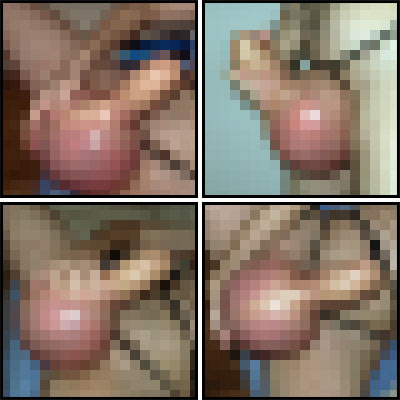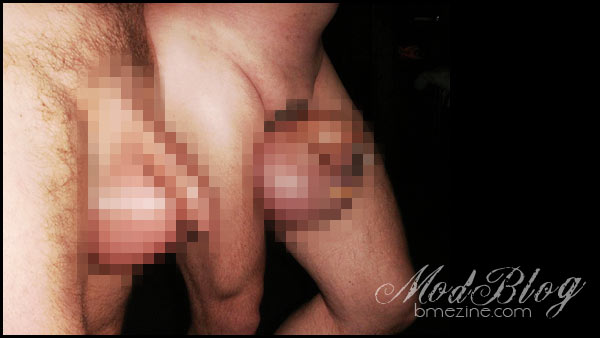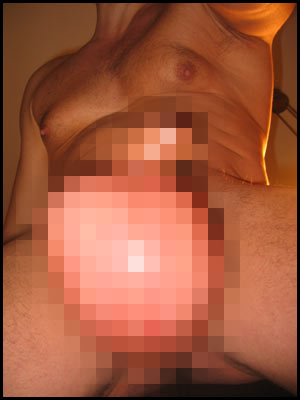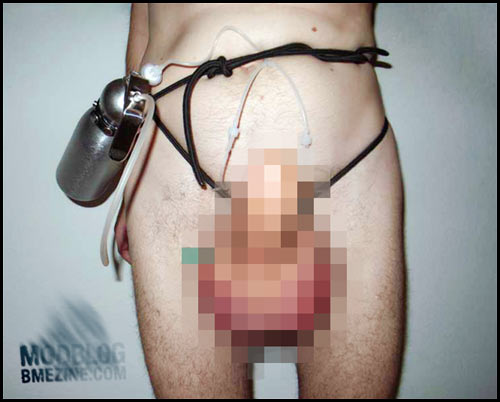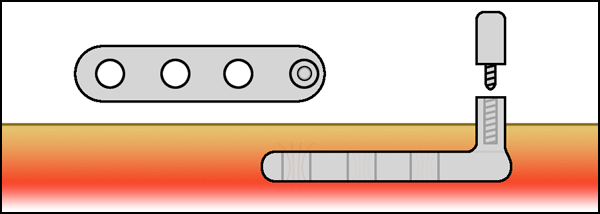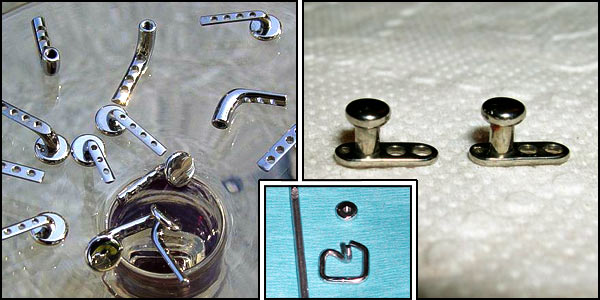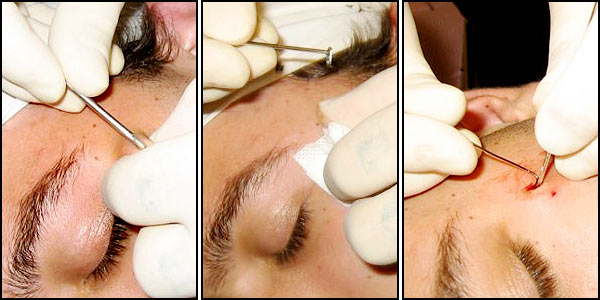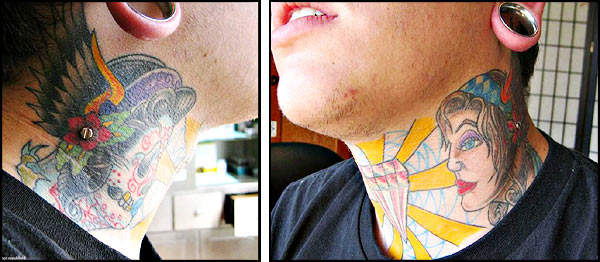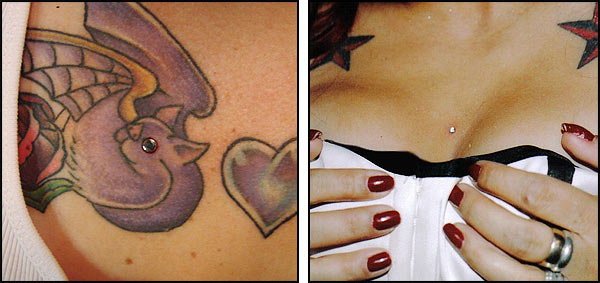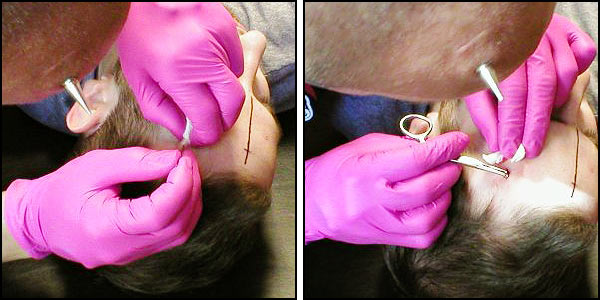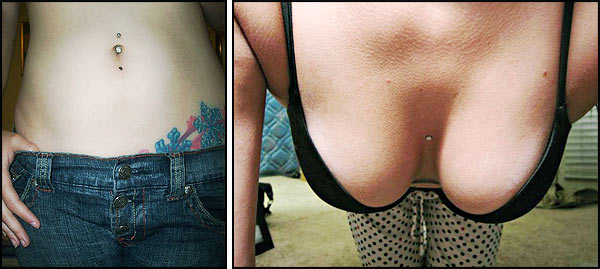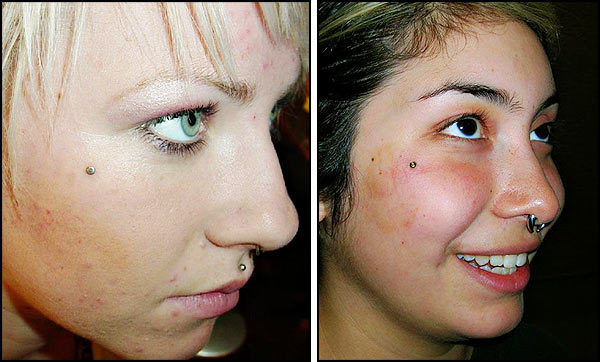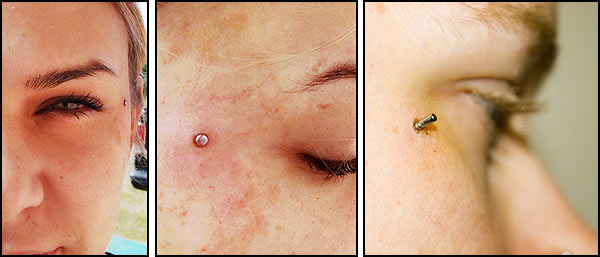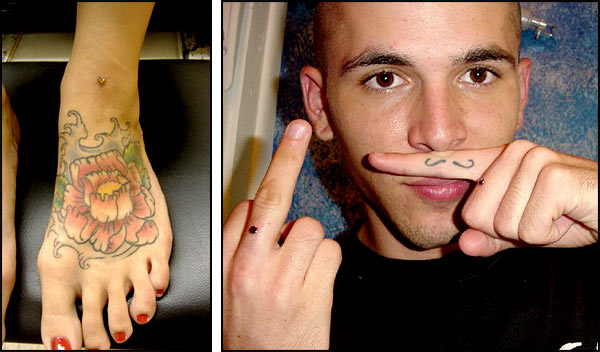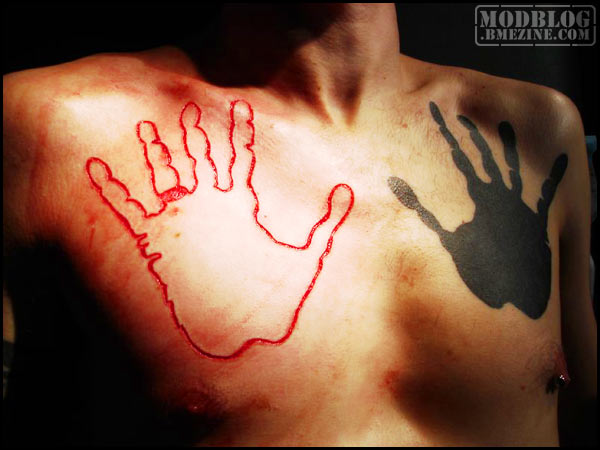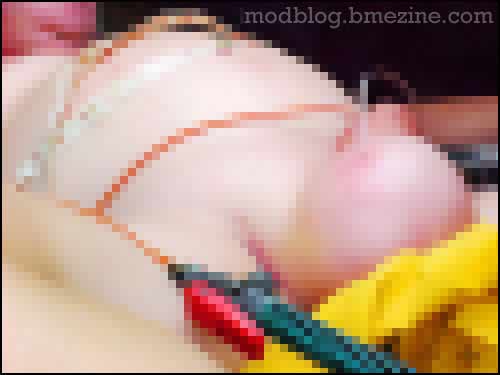|
Martin: Genital Evolution I first met Martin in the mid-nineties when he began experiments in “cock skinning”, a radical sort of circumcision where large amounts of tissue are removed from the shaft of the penis, leaving tightened and scarred skin. While this was not his first journey into body modification, it began a series of heavy duty DIY changes to his genitals that continue to this day — he’s been subincised, closed that subincision, opened it up again (and repeated that more than once), injected hydrogels, reshaped his scrotum multiple times, cut his own suspensory ligament, and more. Thanks to a bullet-proof immune system and the apparent ability to heal almost anything, his adventures just keep escalating. Please be warned that this interview is extremely explicit and deals with highly risky activities, both in terms of the pictures and the modifications discussed. Martin’s Subincision… One of Many!
* * * Tell me a little about yourself. I’m thirty-six now. I was born in Austria, but have lived in the UK for most of my life. I am single and probably always will be unless someone comes along who accepts me for who I am — but I’d much rather be in a relationship. My parents have moved abroad and I have one sister that also lives abroad as well, so I am basically alone here in the UK, although I do have some close friends. I am gay and was very late in accepting it and coming out — I was thirty when I finally came out. I live alone at home with two dogs for company. As for work and everyday life, I am self employed in the electronics trade — repairs to TV and video equipment. It’s a bad career to be involved in, and I would not recommend anyone else starting up in this business since it’s becoming less profitable every year as things become cheaper to replace instead of repair. So you came out with extreme mods before you came out as gay — I guess it was easier accepting your interest in genital modification than your interest in men? Has it been doubly hard striking up relationships because of the genital modifications? I have always been shy and have the fear of rejection, so even before any mods, I’ve never had the courage to ask anyone out. In those days it was only women that I was wanting to find, because that was expected of me by my parents and I could not accept the fact that I was gay. I knew that women never turned me on sexually, but men on the other hand did turn me on. Only the really cute ones — the ones where you could see their package in their tight jeans… it was always the genitals that really did it for me. I have to admit that once I circumcised myself, it did make me even more shy to show my cock, and also, when I first circumcised my cock I did not know about the term ‘circumcision’ and I didn’t even know that other men were circumcised — I thought I made my cock different from everyone else’s! In those days I did not have access to any pictures of cocks and I had never heard about removing foreskin. In school showers all the boys had foreskins. Another thing that bugged me was that my circumcision scar was very defined. You could see the pale inner skin suddenly change to the darker outer skin, with a ring joining the two together. That made me feel embarrassed because I thought that people would know that I’d cut my foreskin off, but since then I’ve found out that that look is very normal in a circumcised penis. Do you think your life would have turned out quite differently had you come out at a much younger age? In a simple answer — yes! If I had the guts to say I was gay before I did any cutting, I might have just gone out and enjoyed myself among other gay friends. I might never have had the thought of that hole in the foreskin, and I might never have made that hole, and then never have had cut the skin, making me not get addicted to cutting in the first place… If I had left my penis well alone as I was when I was born, I’m sure I would have had more courage back then to go out looking for a female relationship and might have gotten married… my genital mods have definitely changed my life, but I don’t really know for certain how much of a change it’s made because I will never know how differently my life would have evolved had I not cut my cock. You mentioned that you run an electronics repair business — do you think your interest and talents in fixing electronics are related on some level to your interest and talents in “fixing genitals”? I know it’s a bit of a goofy question, but I was actually asked a series of questions along these lines myself by some TV show because I was customizing cars and had some in my yard when they came over to film. Funny you should ask that — no, it’s not a daft question at all. There could well be a connection there. Since I was I kid I’ve always been into electronics and anything technical. When I got a transistor radio, the first thing I did was take it apart to see its workings. Everything I’ve had I’ve always pulled apart or tried to modify to make it work better, like modifying coils in TVs and radios to see what effect it had… That could also be why I’m interested in my cock, taking it apart and seeing how I can make it feel and function differently. Ever since I can remember, I was always fascinated with my genitals. Even as a kid before puberty I used to play with my cock, making it go hard and tying rubber bands around it to make the veins stand out. At that time I could not pull my foreskin back and I didn’t even know what a foreskin was — all I could see was the very tip of my glans through the end of my foreskin. I remember my mother giving me a bath. She tried to pull my foreskin back but because it was causing me pain, I didn’t let her, but as the years went by and I entered puberty I started exploring my cock more by tugging on the foreskin, making the opening get wider and wider. I was always too scared to pull the foreskin right back, just in case it got stuck there, or worse yet my glans would fall out — the stupid thing was that I thought that my glans was a separate ball that was only held in place by my foreskin! That’s pretty funny… I’m surprised how early your interested started to show. I think most people see it coming out about the time of puberty. Maybe that means it’s really hardwired in your case! I remember when I was six years old I had a very strange thought… I saw my dad doing a job with concrete around a pipe, sealing it in a floor, and I had thoughts of filling up my pants with concrete so I could no longer access my cock. I thought concrete was so permanent that nothing could break it open after it went hard. I imagined myself wearing concrete pants for the rest of my life — an early thought of chastity I guess! One day in the bath I decided to play and experiment again, and this time I pulled as hard as I could to got my foreskin right back. I held my hand out under my cock just in case the head fell out so I could catch it, but when the skin went back, I was so amazed at how the glans was attached and how very sensitive it was. This made me start off new experiments and I discovered masturbation a few weeks later — it was totally unexpected, but the first orgasm I had I can still remember today. It was so good that I haven’t stopped ever since that day. For several years I just masturbated, but I always wondered what else I could do to turn me on. I knew that it was my dick that turned me on the most. I tried to look at girls, but they just did not turn me on sexually, although young men very much did… Not by their faces — I was more turned on by their cocks. I admired the bulge they displayed in their tight jeans. Back in the 1980’s tight jeans were very commonplace and it was fantastic to see guys wearing tight jeans as long as they showed a bulge. In those days I was twelve, and always promised myself that when I grew up and my cock was bigger I too would wear tight jeans to show off my bulge — and yes, that’s exactly what I now do, and always have. Seeing my cock bulge out of my tight jeans is more of a turn on for me than anything else. Back when I was fifteen I saw a pair of leather punches — I don’t know why, but looking at how they punched a hole in a strip of leather made me want to punch a hole in the top of my foreskin. I never did but the thoughts of having a hole in my foreskin seemed to stay with me. About two years later I was getting bored of masturbating with the same old cock and wanted to make my foreskin pull back further but the frenum was in the way, so one night I got a very sharp pointed kitchen knife and pushed the point through the inside of the frenum and cut it through in an out-and-upwards direction. Because I still had a foreskin I put tissue paper over the cut and closed my foreskin up over it, but it hardly bled at all and it was healed within about a week. What did it feel like? Was the cutting a part of masturbation, or were the two separate? The cutting was a “now or never” spur of the moment thing in the bath. I was having a bath and had that thought about making a hole in my foreskin again, so I quickly decided to do it before I changed my mind. If I would have cum, I would have changed my mind — if I masturbate before the cutting, as soon as I cum the cutting thoughts are gone until next time. I actually use it as a way to slow me down and keep me from cutting myself too often. It’s interesting the role that orgasm plays in it. I know a lot of people who even stop going to orgasm — almost, but not quite there — to avoid losing that feeling, and some even feel bad about the cutting after they cum… If I manage to cum just after a cutting session, I do sometimes feel bad for having cut myself because the erotic excitement is gone, but my biggest piss off is after a major cut and I have to avoid erections in case of bleeding or popping stitches, and sometimes I have to wait for ten or fifteen days before I can masturbate again! It’s the downtime I hate, but the excitement of a newly modeled cock is so erotic, and that’s another reason why I alter and cut my cock. I guess that was how I first started to get interested in modding my cock. I never intended to cut it anymore but then I guess I was already becoming addicted. I think as well because I didn’t have any access to touch and see anyone else’s cock back then, I just wanted mine to feel different. So you did end up eventually making that hole in your foreskin? The thoughts of having a hole in my foreskin never left me, so one night when I was alone I decided to try making a hole, and I cut a small hole from left to right in the area where I could see the ridge of my glans under the skin. When I made this hole I was so turned on at the sight of seeing my glans through the hole that I pushed the glans out through it… That looked really hot, and my proper foreskin opening was now all wrinkled under my shaft and a problem then started. I got very erect and my glans swelled up, and because the hole was too small, it began to strangle the glans and was becoming very painful. No matter how much I tried I just could not push the glans back out from that hole, so I had no choice but to insert the blade from a pair of scissors between the cut hole and the original hole, and cut through that skin. As soon as the blade cut through it, the tightness went away and a strange kind of looseness came, because suddenly the foreskin no longer had any tightness to it when retracted. It was hanging off under my head, which felt sort of uncomfortable but looked really fantastic, seeing my glans with no foreskin trying to slide over it. That said, it was very untidy looking, so one day I thought of trying to repair the skin by opening up the cut edges and sewing them together again, but when I did try that, it was far too painful and I gave up… I knew that I could not leave my cock looking this untidy — after all, I was only eighteen back then and was planning to have relationships. I decided to cut off that lose hanging bit of foreskin, which really hurt, but after it was off, I knew that I wasn’t finished because there were still other areas that needed tidying up. From there on I spent several times cutting bits off to neaten my circumcision scar. Then came a day when I wanted to cut more skin off, mainly because I found it such a turn on to remove skin from my penis. The problem I had was that I didn’t have any loose skin left. I was already very tightly circumcised, but the desire was still with me to cut more skin off. I decided to cut all the skin off my penis shaft — the loosely attached skin that slides along the shaft when masturbating. I made a circular cut around the base, and another cut just behind the head, and then a long cut joining the two cuts. I slowly lifted the skin off as I was cutting it free from the shaft. Did you ever have problems that needed medical attention back then, or ever get caught in any way? I had to go to the emergency room once, and it was a very embarrassing experience! Luckily no, not back then. I was always ready with a whole roll of toilet paper just in case it bled too much. The circumcision was very manageable. The only problem I had was when I was cutting it off — I was sitting on the edge of the bath for nearly three hours trying to cut the lower part of skin off and my parents were due to come home very soon! That cutting was giving me so much pain I didn’t know how to finish it, but luckily I had the idea of going the the freezer and scraping ice from its internal walls into a cup and adding water. I dunked my cock in the iced water and that made it much more bearable and I managed to cut it off before they came home and clear up the bloody mess in the bath. Lucky! Getting back to the cock skinning, what did you do after you cut the skin free? When I was finished I was left with a raw shaft, and it was wet and bloody. I became erect and found that my skinned shaft looked so erotic to me — it was sort of whitish pink in color and it looked hot, but worrying at the same time, seeing my shaft skin start at the base of my cock for only about half an inch, then stop, leaving an opening in my body for my raw skinned cock to protrude from. Martin’s initial cock skinning It took a good eight weeks to heal over fully, with a new scar-like replacement tissue. The trouble I had was the fact that during healing it pulls together, and I was left with a much smaller cock than before. I knew I would never be happy with that so I thought that if I reopened the wound where the new skin joined the remaining old skin, I would pull the edges apart and wait for more new skin to grow in between. This did work and I repeated it twice, and was left with a penis that was about the same as the original length but the skin was totally immobile. The new skin is attached directly to the shaft and has no movement at all to it. How does that feel in comparison? Is it still like that or did it separate and loosen over time? In the beginning the shaft was extremely tight. It was a bit like an hourglass because of the tight bandaging I did to make the new skin heal tightly, but after a few months it softened up and became more normal in shape. The new skin is still tighter than normal skin, and even today and there is no gliding motion anymore. Before skinning it I could feel the shaft meat under the skin, and I could feel the ripples in the cock meat under the skin as I moved my fingers up and down it. I could see all the veins bulging through the skin, but now all that’s no longer possible. It bothered me to start with, but I’m now so used to it that I don’t even think about it anymore The photos make it look like you’ve got no worries in the size department — were you aware of that as you were growing up? It’s only since I’ve been sending pictures on the Internet that I’ve been getting responses saying that I’m quite big. For me I’ve always seen myself as being too small, but that’s only because I wish I was huge. I’ve always imagined myself having a cock that’s so big that I have trouble getting dressed — it’s an obsession for me to wear tight jeans to show a big bulge. It gives me confidence knowing that my dick is big enough to show through my clothes — if I don’t show a bulge, like if I wear baggy jeans, I feel less confident in front of others, especially if I’m among other guys and one or two do show a bulge… it makes me feel even smaller and underdeveloped. After the skinning, how did you get into the subincision and other mods? The skinning took place in 1992 and I didn’t do much after that anymore until 1997, when I got my first computer. The first thing I looked for on the Internet was for information about self-circumcision, mainly to see if other people also did it, and I stumbled across BME and I immediately bought myself an extreme subscription. That was where I first saw subincisions and bisections, and since then it’s been the green light and the inspiration I’ve been looking for to continue with my genital mods. Before that, were you at all aware that other people were doing it as well? In those days I was not aware that others did any kind of self cutting. I thought I was totally alone with it and felt like a freak because of that… I was very relived to find out that I was not alone anymore, and better yet, because the Internet is two way interactive, I’ve managed to chat and contact several others. It’s just a shame that they are all so far away. Did you ever try “lighter” stuff along the lines of pumping or saline? Or was it always cutting that was the turn-on? When it comes to non-cutting mods, yes, I’ve done several, but because they don’t last, they are not as exciting. I have pumped with an electric pump — it was a paint sprayer compressor I modified to suck in air through a tube. The vacuum was so strong that I filled my tube in two sessions, but after only a few sessions it was hurting too much in an aching sort of way, so I gave up. I also used the compressor as an inflater — I attached a needle on the end of the tube and inserted it under my shaft skin and inflated my cock. The base was tied off tight, and I left the pump on until my cock was about to explode — it was so hard including the head. The thing that made me quickly turn the pump off was the fact that I could hear cracking noises in the head! The skin was about to rip open! I could not feel anything because I had injected anesthetic first. Martin’s cock being inflated Releasing the pressure I got a large needle and stabbed my cock from all directions. The air hissed out of my cock, along with bubbles of blood. While I was tied off, after I had squeezed all the air out, I got a pair of scissors and inserted one blade in my piss hole and the other along the top center of my glans and I split it through — there was no blood and no pain, so I suddenly had a split head! I inserted a tube down my urethra and wedged tissue between the split, and then tightly bandaged the head up and released the band at the base of my cock to allow the blood to flow in again. Amazingly, it didn’t bleed at all… It went red, and soaked in blood, but it never ran or dripped with blood, so that was good. Martin’s head splitting I know it was a stupid thing to do — I knew it when I did it — but I thought I’d take the chance because I wanted to see how big I could inflate my cock. Yes, I was stupid to have done that, so don’t tell me I was because I know anyway! I’d love to hear the stories of of your subincision and how you came to close it up. Back in 1987 I was in the airport in Austria waiting for my flight, and that was the very first time I had ever thought about subincision. I didn’t know even that it was possible, yet alone knew that others did it — it was a thought totally out of the blue and I even remember where I was when that thought came to mind. I didn’t call it a subincision, I called it a gutter! I never did it for may years after, but I did decide to experiment with that thought, and one night in the bath I decided to lengthen the piss slit. I did this by tyeing off my cock, putting ice on it to deaden the pain, and got a blade and cut myself a meatotomy all the way to the rim of the glans. I was amazed at how easy it was, and the fact that it was even possible to do. It healed quite quickly but I found that peeing standing up was bad — it sprayed everywhere and I hated that, so after one year I decided that it must be possible to close it up. I opened the healed sides — back then I didn’t have access to anesthetic so I used freezer spray, a spray can that’s used for cooling electronic components when tracing thermal faults. I sprayed it on my meatotomy edges and my glans became white, hard, and frozen on the two sides of the meatotomy. I quickly got scissors and sliced a chunk off the glans from either side. By then it was thawing out and becoming soft again, so I brought the two sides together and taped it up with surgical sticky tape. When the feeling came back it hurt so much I nearly cried… After that, peeing was done very slowly so as not to put too much pressure on the wound, and after a few days it had knitted together and it was totally healed in about two weeks. It wasn’t until 2000 that I decided that I wanted a meatotomy again, mainly because I then knew that others also did it, so I decided to reopen my meatotomy again, but this time I stopped about a centimeter into the shaft. It was amazing to see the inside of my cock again, and because I knew others also cut themselves I knew I wasn’t a freak to cut myself, so I just continued to cut. Returning to the first thoughts of a subincision back in that airport, when I stumbled across pictures of my first subincision all my memories came back to me. I just could not believe that someone had actually done that to their cock… Back then I had promised myself not to cut my cock anymore, but every time I looked at subincision pictures, particularly the full subincisions, I knew I wanted one on my cock one day too. After I redid the meatotomy, I left it to heal, always knowing that I wanted to extend it further. A few months later I cut it further using a clamp-and-cut method. I did this twice more and I loved the feeling of how my urethra fell open wider each time — the feel of air hitting the sensitive tissue gave me a real hard on, and I came after only a few strokes! Closing his subincision By the end of the year I had a full subincision and I loved it, but one night I was having a bath and I had the thoughts of extending my sub further, and as I got the blade near it, I wondered if it was possible to repair it again. I opted for the latter, and in an attempt to be “normal” again, I used injectable anesthetic and removed a strip of skin from each side of my sub and then sutured it all together. During the next few days peeing was rather painful and I had to control how hard I let the pee flow — it’s really difficult to trickle out pee when you’re bursting to go! But, after a week it was knitted together enough to not rip apart anymore. I left my entire shaft tightly bandaged so that erections didn’t put too much strain on the rejoined area. Martin’s closed subincision But that closure didn’t last, did it? No — I have reopened it again, and this time it’s all the way to the scrotum. I plan on splitting the scrotum again as well and taking the subincision between the balls. I assume everything you’re doing is cock-related? No changes to any other body parts at all? I am only interested in modifying my cock. Other body parts don’t turn me on in any way, although some look cool on others… but for me it’s only my cock. Let’s keep talking about your modifications… What came after the subincision? A year after that I did my next extreme modification. I was not happy with the way that after my tight circumcision and skinning that my scrotum was pulled up covering more than half the length of the under side of my cock shaft. I had this idea to cut the scrotum away from the shaft to try and make it hang lower down. I’m going to guess this story begins with “I was in the bath”… Yes — I was in the bath and my scrotum was loose and floppy from the heat of the warm water. I injected anesthetic into the area that I was going to cut, and I then got a long blunt object (the handle of a screw driver), and I pushed this handle on the left side of my scrotum as far back as possible and felt for it bulging through the scrotal skin on the right side. Once I was happy with the position, I got a blade and cut from the right side through to the left, using the handle as a base to cut against. I cut until the handle pushed through to the other side. I suppose it could be classed as an extremely deep scrotal or lorum piercing. Martin’s scrotal release I then got a pair of scissors and inserted one blade through this hole and out the other side, and then slowly began to cut in an outward direction along my shaft. This was totally painless, and once I cut through, my scrotum fell downwards, exposing the tops of my balls and the raw underside of my penis. It did bleed quite a lot, but with compression, it stopped after about thirty minutes — I think I must have cut a big vein! I then sutured the scrotum together joining the left side to the right, but left my penis raw above it. It took about two months to fully heal, and I did regrow about half way up the shaft again, but it was definitely lower down than before. I wanted it to be as low down as possible, so I decided to repeat this cutting procedure a second time around. Once it healed the second time, my scrotum was hanging very low and virtually between my legs. I liked it that way a lot but I wanted more and decided that I wanted to split my scrotum so I’d have two independent balls hanging. How did you perform the scrotal splitting procedure? I used the same technique of using the handle of a screw driver as a cutting guide behind the scrotum and I cut to it from the front. My goal was for maximum separation, so I made sure that I cut as high up the scrotum as possible. This time however I did not cut the scrotum in half — I decided to wait until the hole I just made healed, and I inserted a thick tube through that hole and formed a ring out of it, holding it together with a cable tie. After about three weeks it was time for me split the scrotum in two, so I removed that tube and had a nearly healed hole at the base to cut out from. I injected anesthetic again, and used scissors to cut from the hole downwards. After the final snip my two balls fell apart — I could suddenly hold them, one in each hand, about six inches apart! I loved that new look and feel, but there was one problem after it had healed — because my scrotums were so small, they tended to shrivel up when cold and my balls would disappear up next to my cock leaving two empty scrotums that looked like two bits of loose skin. I wanted to keep my balls down in the sacks so I decided to do more cutting. Martin’s split scrotum The next cut was an attempt to make the neck of my left scrotum only thick enough for the cord of the testicle. This was a bad idea, but I did it anyway, not thinking about the consequences. I felt for my testes cord and pushed it to the outside edge of the sack. Then I made a hole in the neck of the sack right next to the cord. I left that hole to heal, using the tube as I did when I split the sack. After it had healed I cut the scrotum through the hole towards the center horizontally, leaving just the part that had my cord running through it. There was blood everywhere and I had to call for an ambulance as I could not stop the bleeding — that was the most embarrassing day of my life! But it healed quite well and my left testicle was now hanging in a scrotum from a thin neck, sort of like a pendulum between my legs… But after a few months, due to cold weather, it managed to squeeze past the narrow neck and up next to my cock, so it didn’t work as planned. How did they react to you at the hospital? An Indian doctor came to check me over, and saw what I had done. He said that if I cut too close to the cord of the testes, that the thin scrotal neck could swell and strangle the cord and I could loose that ball. I already had it in my mind that I was going to loose my left ball, but the doc then said that there was no point in suturing the wound together, because I’d already done a good job of that. I was surprised, and he looked at my then partial subincision and asked if I did it. I told him I did and he said that I would have problems with it later in life — I don’t know what he meant by that. He wanted to keep me in on an IV drip, but I refused and dismissed myself. They gave me a packet full of pills and I went home and was at work the next day. How did the ligament cutting happen? DIY is certainly a better deal than paying $3000 or so to have a plastic surgeon do it… I injected the area with anesthetic and pulled hard on my penis in a downward direction. When I felt the pubic area I could feel ligaments through the skin tensioning up and it was these ligaments that I planned to cut. I got a blade and made a hole just over the area that I could feel the ligaments through, and I cut that hole about half an inch across and dug the blade in on one side of the tensioned ligament and cut towards it. I could hear the tearing sound, and once I cut through it my cock suddenly felt longer and I could actually see it drop lower down! Martin’s DIY ligament cutting It was one of the easiest mods I’ve ever done. I sutured the hole shut and I was even able to masturbate the same night! I had bruising for about one week but I gained just over one inch when soft. But it still wasn’t enough. Wow, I didn’t realize that it was that “easy” to do… Did you gain any hard length as well, or just when soft? Yes, I found it the easiest mod ever, but I didn’t notice any more length when hard. I did notice however that my cock hangs lower down… I never did any stretching, although I should have, but having said that, I didn’t loose any length that I gained and I now can no longer feel the ligament under the skin anymore. Has it changed things like angle of erection and so on as well? My angle of erection was pointing down long before the ligament cutting because of a lot of manual pulling downwards on my cock by hand at every available moment. Every time I had to go to the toilet, I always ended with a real hard pull on my cock in an attempt to stretch it — there was a time I could put the head in my mouth, but I stopped pulling on it because the results were too minimal. That’s why I opted for the ligament cut. Maybe I might try pulling on it again soon, as I might get more length now that the ligament is cut. What other things have you tried to increase the size? I had heard of Hydrogel and was given a contact address to obtain some. First I wanted my cock to look normal again before I injected it so I decided to close up the full subincision. This was my second-time-round subincision, as I had already closed it up before and then cut it open again. I removed a slice of skin from along each side and sutured the two sides together, but this time I left a hole right at the base in order to pee through so my pee pressure would not disturb healing on the rest of the sub. After it was healed I had to close that hole in the base so that I could pee from the end again, and I removed a ring of skin from around that hole and sutured that open ring closed. For the first few days I was very careful not to pee too hard, and within a week I was able to pee standing up again. I managed to close my subincision down to a 5mm pee hole in the glans! Opening up his “mostly” subincision After my sub was closed again, I decided that I wanted my scrotum back as a whole so that I could inject the hydrogel into it and get a big round bulge, but I had problems with my left sack when trying to join it to the right one. I cut open the right sack until it was fully open in the area that was originally split, and then I tried doing the same with the left one but the narrow neck where the cord was running through was so close to the testicle that when I cut it open, my testicle popped out and fell in my hand, hanging from its cord. It was out of its internal sack too, and started to give me stomach cramp pains. I started to panic because I could not push it back in, and I fumbled about for several minutes in pain and finally I pulled my stomach in while breathing — that tends to pull the balls up. Luckily my testicle pulled up into the mutilated scrotum, and I quickly sutured the two sacks back together again. Martin’s scrotal split reversal It has healed surprisingly well. You wouldn’t think that my sack was ever split if it wasn’t for the scar along the center. Then it was time for the hydrogel. I ordered 250ml and have used most of it. I’ve injected it into my shaft under the skin and it’s made my cock very thick, but I’ve also tried injecting it into the scrotum, but it seems to make lumps instead of evening out. It feels like I have three balls… I wasn’t happy with that, so I removed it from the scrotum again. Were there problems due to the way your skin is attached so tightly? No big problems — although it was not possible to inject along the bottom of my shaft because it was my closed subincision, so there were no skin pockets under there at all. Along the sides and on the top was loose enough for injecting the gel. You ordered the Hydrogel from China I guess? Yes, I did, but recently I have heard of something even better, apparently it’s a filler that’s made up of small spheres, like micro beads. The Hydrogel is good, but I can squeeze it back out if I wanted to — I’d like something that can’t be removed! I find the permanence of a mod so erotic. To get the Hydrogel out all I needed to do was make a hole in the area with a needle and squeeze it out like a tube of tooth paste. But now you’ve opened your subincision up again? I’ve always loved the look of subincisions and after repairing mine I was missing having it, so after nearly two years of having it fully repaired I decided to reopen it again. I have since cut it right up to the scrotum, and it’s longer than the original full sub I had by about an inch. I like the feel of the exposed urethra so much so that I wanted to feel it all the time, rubbing in my pants, but because my sub is more of a deep groove I needed to find a way to open it out flat. I decided to remove a length of shaft skin from along the top of my cock. I cut off a sheet of skin that was about an inch and a half wide by three inches long, and I brought the edges together and sutured it, making my sub underneath open out really tight and flat when soft. I then wrapped my cock tightly in tape and dressings so that erections wouldn’t pull the sutures apart. After about two weeks it was time to test the results. I removed the dressings for the final time and let myself get fully erect — wow, that was rather painful to start with. The sub was so stretched wide open, it was shiny and very tight, and when soft my sub is now totally flat and fully exposed permanently. It feels great in my pants when walking about, but the skin has loosened up a bit since, and now there is no way that I could ever re-repair my sub. It’s now permanently open. Martin’s top cut It’s not going to end here. I plan on doing lots more in the future, and my next plan is to re-split my scrotum, because as with my sub after repairing it, I now miss the feel and look of having two balls. Next time I plan on first making a transscrotal big enough to push my cock through. I’m also very seriously thinking about a fully split penis — I would want it split so far back that when hard I’ve got the split starting right at the pubic area. I can’t wait to hear what happens next. Thanks for sharing your story, and I look forward to talking to you again!
|




































